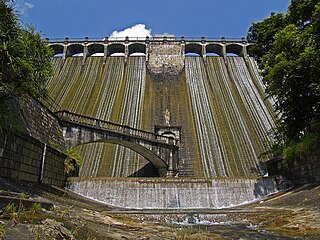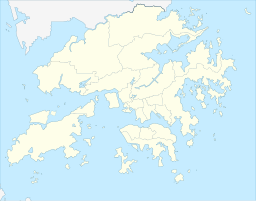
Mui Wo is a rural town on the eastern coast of Lantau Island in Hong Kong. The 2011 Census recorded 5,485 people living in Mui Wo and its environs.

Shing Mun Reservoir is a reservoir in Hong Kong. It is located in Shing Mun,the area between Tsuen Wan and Sha Tin,in the New Territories.

Pat Heung is an area in the middle of New Territories,Hong Kong. Located at the east of Kam Tin and north of Shek Kong,it is the exit to Sheung Shui and Fanling. Administratively,it belongs to Yuen Long District.

Pat Sin Leng Country Park is a country park in Hong Kong located in the northeastern New Territories. Established on 18 August 1978,the country park covers 3,125 hectares of natural terrain. It comprises the Pat Sin Leng mountain range and other spurs,including Wong Leng,Ping Fung Shan,Cloudy Hill and Kwai Tau Leng. Hok Tau Reservoir and Lau Shui Heung Reservoir are also within the country park.

Kowloon Reception Reservoir,part of the Kowloon Group of Reservoirs,is a reservoir in Kam Shan Country Park,Sha Tin,New Territories,Hong Kong.

Lau Wong-fat,GBM,GBS,OBE,JP was a Hong Kong businessman and politician. He had been the long-time chairman of the Rural Council,the most powerful organ representing the interests of the New Territories indigenous inhabitants from 1980 to 2015. He was also a member of the Legislative Council of Hong Kong from 1985 to 2016. From 2009 to 2012 he was a non-official member of the Executive Council of Hong Kong. He had also served as the member of the Chinese People's Political Consultative Conference and chairman of the Regional Council and the Tuen Mun District Council.

Lam Tei is an area in the Tuen Mun District of the New Territories,Hong Kong. The region lies at the north end of Tuen Mun city. It is highly rural,with Miu Fat Buddhist Monastery being a landmark of the region.

Shek Pik Reservoir is a reservoir in Shek Pik on Lantau Island in Hong Kong. Built between 1957 and 1963,it has a storage capacity of 24 million cubic metres and is the third largest reservoir in Hong Kong after High Island Reservoir and Plover Cove Reservoir.

Tai Tam Intermediate Reservoir,part of the Tai Tam Reservoirs,is a reservoir in Tai Tam Country Park,Tai Tam,Hong Kong Island,Hong Kong and has a water storage capacity of 19.6 million gallons. The reservoir was completed in 1907.

Tai Tam Byewash Reservoir,part of the Tai Tam Reservoirs,is a reservoir in Tai Tam Country Park,Tai Tam,Hong Kong Island,Hong Kong and has a water storage capacity of 22.4 million gallons. The reservoir was completed in 1904.
Kwan Tei River is a river in northeastern New Territories,Hong Kong. Its source is from the Lau Shui Heung Reservoir. The river flows through Lau Shui Heung Village and underneath Sha Tau Kok Road before joining Ng Tung River near Kwan Tei Pei Village.

The Aberdeen Reservoirs are a group of two reservoirs,consisting of the Upper Aberdeen Reservoir (香港仔上水塘) and the Lower Aberdeen Reservoir (香港仔下水塘),in Aberdeen,Hong Kong.

Heung Yuen Wai Highway,also abbreviated as HYWH,is a controlled-access highway in North District,New Territories,Hong Kong. It diverges from Fanling Highway of Route 9 at Kau Lung Hang,crosses Sha Tau Kok Road and connects to Heung Yuen Wai Control Point,an upcoming border checkpoint between Hong Kong and China now under construction.

Lam Tei Reservoir is a funnel-shaped reservoir located at the back hill of Lingnan University in Fu Tei,Tuen Mun,Hong Kong with an area of 17,000 m2 and a water storage capacity of 116,000 m3. It is located at the western edge of Tai Lam Country Park and less than one kilometre away from Hung Shui Hang Reservoir. Like Hung Shui Hang Reservoir,it is part of Tai Lam Chung Reservoir's further water supply plan and an irrigation reservoir. The water from the reservoir eventually flows through the Tuen Mun River and empties into the Castle Peak Bay. The reservoir can be accessed by Stage 2 of the Tuen Mun Trail.

Hung Shui Hang Reservoir is a reservoir located to the north of Kau Keng Shan,Tuen Mun,New Territories,Hong Kong. It is located at the northwestern edge of Tai Lam Country Park and less than one kilometre away from Lam Tei Reservoir. Like Lam Tei Reservoir,it is part of Tai Lam Chung Reservoir's further water supply plan and an irrigation reservoir. The reservoir is divided into two reservoirs. The water from the reservoir flows through Tan Kwai Tsuen and Chung Uk Tsuen and then through Hung Shui Kiu,passing through the west side of Tin Shui Wai and finally empties into the Deep Bay.
Lau Shui Heung is a village in Fanling,North District,Hong Kong.















